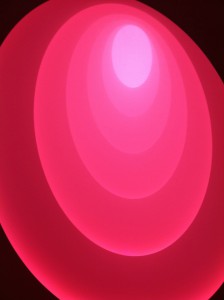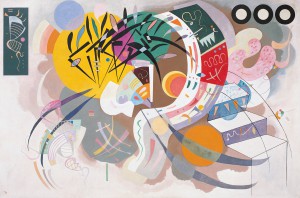“My art deals with light itself. It’s not the bearer of the revelation – it is the revelation.” James Turrell
Even people who have never visited the Guggenheim (we call them Muggles) know its trademark shape. Frank Lloyd Wright changed art museums forever when he designed the center rotunda and surrounding ramps, which are reflected in the exterior shape of the building. You can buy Lego Guggenheims, Guggenheim-shaped lamps, and kits to build tiny paper Guggenheims. The Guggenheim even features in the video game Happy Street (free at the app store – highly recommended because it’s HAPPY).
James Turrell has altered everything you know about the Guggenheim. His Aten Reigns installation walls off the ramps (which are shorn of their art anyway). Sitting in the first floor rotunda, visitors stare straight up at the changing light show, or lie on the floor to see the ceiling oculus. Is this a Pantheon? It feels like a tribute to the gods – or maybe a gift from them. Aten, after all, is the name the ancient Egyptians gave to the sun and to their first monotheistic god.
There are also several smaller light installations, plus a collection of Turrell’s aquatints that glow with light. You may have to stand in line, but it moves quickly and is worth it.
While you’re at the museum, do yourself a favor and look at the excellent collection of Kandinskys from his Paris period. I’m a big Kandinsky fan and especially enjoy tracing his travel from figurative to abstract work. These paintings from the ’30s and ’40s fall on the abstract side, but just barely, which means that you can see space and identify shapes in them – just as in the best abstract art. Kandinsky has a magical touch when it comes to combining the whimsical with the substantial. I especially enjoy his Petits accents (below) in which small birds, other creatures, houses, and random shapes perch on what might be electrical lines, and just as well might be a musical score or lined paper. Where do you think it belongs on the Kandinsky continuum between representational and abstract? Does the label matter? It is delightful.





